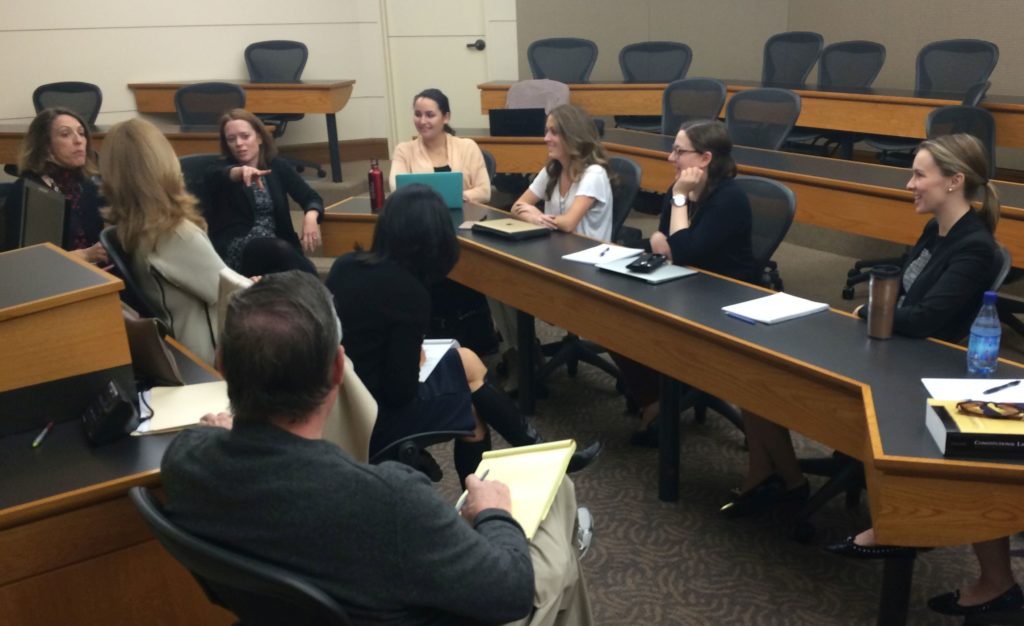Stanford Law School Students Want to Break ‘Impenetrable Concrete’ Ceiling for Women Lawyers

STANFORD, Calif. – June 1, 2016 – In 1995 the authors of a Fordham Law Review article called “Glass Ceilings and Open Doors” predicted that women would gain equal representation as law firm partners by 2009. That hasn’t happened. In fact, despite a steady stream of close to 50 percent female law graduates and entry-level law firm hires over the past 30 years, women make up just 18 percent of law firm equity partners – only 2 percent higher than in 2006, according to the American Bar Association.
“This very slow pace of changes makes it seem as though the ceiling is not so much glass as impenetrable concrete,” says a white paper released today by four Stanford Law School (SLS) students called “Retaining and Advancing Women in National Law Firms.”
During four months of intensive study, the four SLS students learned that women lawyers work longer hours but bill fewer hours than men, earn lower incomes than men, get less credit for generating business, have less access to mentors and informal networks, and are significantly underrepresented in positions of leadership at major law firms.
Obstacles and Opportunities
The paper outlines 23 causes of these inequities in great detail and issues 16 recommendations for overcoming them. The students stress that there is no “silver bullet” that will ensure ongoing retention and promotion of women in national law firms and recommend a multifaceted approach of specific, actionable steps to attack “the broader cultural and sociological factors that underlie the key problems being addressed.”
“It’s apparent that the legal profession’s gender gap is not going to close without deliberate and focused effort,” said Susan Robinson, Associate Dean for Career Services and Lecturer in Law at SLS. “This study identifies creative ideas for tackling the problem in a variety of ways.”
“All of our graduates rightly expect to enter a profession where women advance to leadership positions, just as their male peers do, and yet the data show that the gender gap in the profession is stubbornly persistent. The students in this practicum have taken on this problem and documented both the causes of the gap as well as promising solutions that will break down the barriers to women’s advancement in the profession,” said M. Elizabeth Magill, Richard E. Lang Professor of Law and Dean at Stanford Law School. “I am confident that, as the next generation of young lawyers, they will be primed to make a difference.”
The four authors, Anna Jaffe, LLM ’16, Grace Chediak, JD ’17, Erika Douglas, LLM ’16, and Mackenzie Tudor, JD ’17, wrote the paper as part of a Stanford Law School practicum designed to identify the causes of the gender gap in the legal profession and to propose possible solutions. Their findings were shared with participants in the upcoming inaugural Women in Law Hackathon on June 24 at Stanford Law School to further their thinking leading up to the competition. Fifty-four partners from national law firms will be competing as part of nine teams, each with six lawyers and one SLS student.
Seeking the Best Solutions
The Hackathon, a Shark Tank-style pitch contest that will reward the best solutions, was conceived by Diversity Lab, an organization committed to closing the gender gap and boosting diversity in organizations at the leadership level, in partnership with SLS and Bloomberg Law. Bloomberg is contributing cash prizes to the three top winners that will be donated to nonprofit organizations helping to advance women in the legal profession and beyond.
Among the study’s key findings are:
- In-group bias and homophily (the tendency of individuals to associate and bond with others like themselves) impact the retention of women in law firms, particularly women of color.
- Women lawyers receive lower compensation than their male counterparts at all levels due to non-objective criteria, contributing to women lawyers’ attrition.
- Women lawyers are not receiving fair credit for the generation of business as a result of a number of structural and social barriers.
- The subjective nature of the attorney evaluation process is exacerbated by the influence of stereotypes and dominant ideologies.
- Women are significantly underrepresented in positions of leadership (particularly on compensation committees) at large law firms.
- Women lawyers are likely to be disadvantaged in their advancement due to the lack of availability of informal networks and, therefore, access to rainmaking opportunities.
The study’s recommendations include:
- Ensure that firm leaders and partners are held accountable for the outcomes of diversity and inclusion efforts.
- Take steps to ensure that a “critical mass” of women is appointed in leadership roles at law firms, particularly to the compensation committee.
- Ensure greater transparency and objectivity in compensation at all levels in firm hierarchy but particularly at the partnership-decision level.
- Create objective evaluation criteria and communicate those criteria to associates.
- Provide regular feedback and monitor for bias.
- Centrally monitor the distribution of assignments in practice groups to make sure that associates are getting the opportunities they should.
“While our research uncovered lots of barriers to the advancement of women in the legal profession, we also talked with many people who are eager to solve this problem,” said Anna Jaffe, lead author of the white paper. “We are hopeful that firms will embrace new approaches that create new and substantive opportunities for women to lead.
The white paper, “Retaining and Advancing Women in National Law Firms,” is available online at http://stanford.io/1TPczwL. A story about the practicum in the latest issue of Stanford Lawyer called “Bridging the Law Firm Gender Gap,” by Randee Fenner, BA ’75, is available at http://stanford.io/1XNAhZT.
